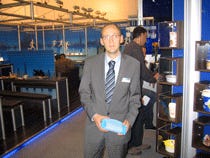Kraft Foods keeping a sharp eye on T-IML
How bright is the future for thermoformed packaging with labels applied inmold? A chance encounter at last week's K show led to a long discussion with one of Kraft Foods' packaging experts. Based on developments in suitable labels, plus tooling and automation, he thinks T-IML holds plenty of promise.
November 9, 2010
How bright is the future for thermoformed packaging with labels applied inmold? A chance encounter at last week's K show led to a long discussion with one of Kraft Foods' packaging experts. Based on developments in suitable labels, plus tooling and automation, he thinks T-IML holds plenty of promise.
MPW met Jameel Ahmed at the K show stand of tooling specialist Marbach (Heilbronn, Germany) as he was discussing Marbach's thermoformed tooling developments with Hubert Kittelmann, Marbach's VP sales. Ahmed is an associate principal engineer focused on R&D plus quality for the brand owner's grocery products' business. Marbach's stand at the show, which ended on Nov. 3, was dominated by inmold labeled packages, both injection molded and thermoformed.
|
Marbach is best known as a supplier of tooling for thermoforming but in February 2008 acquired Systec Komplettsysteme GmbH (Bad Urach, also Germany), best known as a manufacturer of automation systems [inmold labelling (IML) and parts handling systems] for injection molding. Marbach acquired Systec because it recognized that many of its customers use both thermoforming and injection molding, and wanted a systems supplier for both. Kittelmann said the acquisition has helped his company also learn much more about the use of inmold label automation for thermoforming.
IML's use in thermoforming has been slow getting beyond the R&D stage. There are less than five commercial T-IML lines running, with one starting soon at Tech II in the U.S.; Marbach helped with this project but the tooling for it came from another supplier. Marbach's T-IML work extends back more than a decade, but the sole label supplier back then went bankrupt, causing years of essentially no movement on the technology.
Now, interest is again strong, there are multiple labels suppliers, and these are investing in development of labels specifically for thermoforming. During thermoforming, inmold labels need to bond with the plastic substrate at much lower temperatures than with other processes, so special labels are required. In addition, said Ahmed, thermoforming offers some important advantages over injection molding that make it a good choice for some very high-volume applications. T-IML labels currently are available only converted from polypropylene but Kittelmann said work is ongoing on such labels made from PET and polystyrene.
Ahmed keyed on two aspects of thermoforming: its ability to produce more, and better, barrier packaging than injection molding, and its ability to produce packaging with thinner walls. "T-IML with barrier—this could be a big trend as injection molded barrier containers just are not as good" as comparable thermoformed ones, he said. The problem, of course, will be developing the means to insert labels into tooling large enough to take advantage of thermoforming's tremendous volume production. To date, say insiders, the largest inmold labelling system is an 8+8 cavity one used in an injection molding cell for cream cheese containers. Thermoform tooling, in comparison, is typically 32 cavities or much higher. Tech II's line will include a 12-up tool but it is capable of being increased to 21 cavities.
According to Kittelmann, adding IML to a thermoforming line will slow productivity by about 20%, using current automation systems. "But when you have a premium product, you want a premium package," said Ahmed. "That's why in thermoforming, you've not really had much success yet" in the premium products' range. "But with T-IML, that could all change," he predicted. Plus, he added, the need to distinguish products on a shelf is only increasing in importance, citing this as another reason T-IML has a good chance of succeeding. In addition, thermoforming's ability to form very thin walls could save enough material to offset the cycle time penalty.
The market continues its shift to smaller package sizes and to single-serve packaging, noted Ahmed, with this shift making premium packaging all the more important. That being the case, he added, T-IML "seems almost predestined" to find purchase in the industry. —Matt Defosse
About the Author(s)
You May Also Like



